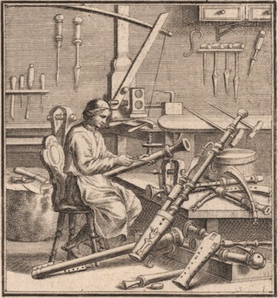Tags
Antonio Cesti, Baroque bassoon, basso continuo, bassoon, bocal, cane, double reed, dulcian, dynamics, embouchure, fagotto, Guntram Wolf, Il Pomo d'oro, Jacques-Martin Hotteterre, Johann Christoph Denner, Johann Christoph Weigel, Johann Friedrich Fasch, Kammerton, Les Petites Violons, Lully, Michael McCraw, oboe, opera, recorder, reed, Regensburg, shawm, Telemann, Vivaldi, William Waterhouse

Poverty is like a woodwind instrument:
It makes palpable the breath of love and arouses the fingers with generosity.
Its sound of thanks fills one with joy, and, by piercing the clouds, it showers blessings upon us all.
In this engraving published by Johann Christoph Weigel in Regensburg in 1698, a woodwind instrument maker is putting finishing touches on a dulcian while a completed bassoon leans against his workbench. Music historians generally consider the dulcian to be the forerunner of the modern bassoon, as the two instruments share many characteristics: a double reed fitted to a metal crook, obliquely drilled tone holes, and a conical bore that doubles back on itself.
The origins of the dulcian, or fagotto in Italian, are obscure, but by the mid-sixteenth century it was available in as many as eight different sizes. Its primary function was to provide the bass in wind consorts made up of either loud shawms or soft recorders, indicating a remarkable ability to vary dynamics to suit the need. Otherwise, only eight finger holes and two keys limited each size of dulcian’s usefulness to very few key signatures.
It appears that the Baroque bassoon was a newly invented instrument, rather than a simple modification of the one-piece dulcian, but the dulcian continued to be used by Bach and others alongside the bassoon well into the eighteenth century. The person most likely responsible for developing the more advanced bassoon was Jacques-Martin Hotteterre. Some historians believe that, sometime in the 1650s, Hotteterre conceived the three-keyed bassoon in four sections (bell, bass joint, boot and wing joint), an arrangement that allowed great accuracy in wood machining. While no French instruments from that time period have survived, bassoons from the 1680s of Johann Christoph Denner and Richard Haka are still extant.
Composers first used the bassoon to reinforce the bass line of the string orchestra or as the lowest voice in a double reed choir of oboes and tailles. Jean-Baptiste Lully combined the newly invented oboes and bassoons with strings in his Les Petits Violons. Antonio Cesti included a bassoon in his 1668 opera Il Pomo d’oro. The use of bassoons in concert orchestras was sporadic, however, until the late seventeenth century when double reeds began to make their way into standard instrumentation. This was largely due to the spread of the oboe to countries outside of France. Increasing use of the bassoon as a basso continuo instrument meant that it also began to be included in opera orchestras, first in France and later in Italy, Germany and England.
Sometime around 1700, a fourth key was added, and it was for this type of instrument that Vivaldi, Telemann and Bach wrote their demanding scores. A fifth key was added during the first half of the eighteenth century. Notable makers of the four-key and five-key Baroque bassoon were J. H. Eichentopf; J. Poerschmann; Thomas Stanesby, Jr.; G. H. Scherer and Prudent Thieriot.
Today, many Baroque bassoonists in North America play a reproduction of a late seventeenth-century instrument discovered by William Waterhouse in the former East Germany. The Model HKICW by Guntram Wolf Holzblasinstrumente features a wing joint and bocal that pitches the instrument at a’ = 415 Hz, the Kammerton at which most historical woodwind instruments are pitched.
Reeds for Baroque bassoons vary widely among players. Not only do the physical characteristics of cane vary from one shipment to the next, but every possible design variable, including length, profile, gouge, shape, diameter of cane, etc., is investigated by each player in an effort to derive the best musical effect from his or her Baroque bassoon.
A great degree of flexibility of pitch control, through the use of breath support and embouchure, as well as reed profile, is available to bassoonists, and players can also use alternate fingerings to adjust the pitch of many notes. In a manner similar to other woodwind instruments, the overall length of the bassoon can be slightly increased to lower pitch or decreased to raise pitch. On the bassoon, this is done by pulling out or pushing in the bocal, the curved metal piece to which the reed is attached.
With warm and lyrical tone, Baroque bassoonist Michael McCraw is featured in an online performance of the Concerto for two Oboes and Bassoon in C minor by Johann Friedrich Fasch.

Pingback: Duo Crezdi to Appear in Recital |
Pingback: Gardiner Conducts High-Stakes Motets | Boulder Bach Beat